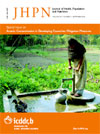
|
The Journal of Health, Population and Nutrition
icddr,b
ISSN: 1606-0997
EISSN: 1606-0997
Vol. 35, No. 1, 2016, pp. 1-10
|
 Bioline Code: hn16027
Bioline Code: hn16027
Full paper language: English
Document type: Research Article
Document available free of charge
|
|
|
The Journal of Health, Population and Nutrition, Vol. 35, No. 1, 2016, pp. 1-10
| en |
The effects of MCH insurance cards on improving equity in access and use of maternal and child health care services in Tanzania: a mixed methods analysis
Kuwawenaruwa, August; Mtei, Gemini; Baraka, Jitihada & Tani, Kassimu
Abstract
Background: Inequity in access and use of child and maternal health services is impeding progress towards
reduction of maternal mortality in low-income countries. To address low usage of maternal and newborn health
care services as well as financial protection of families, some countries have adopted demand-side financing. In
2010, Tanzania introduced free health insurance cards to pregnant women and their families to influence access,
use, and provision of health services. However, little is known about whether the use of the maternal and child
health cards improved equity in access and use of maternal and child health care services.
Methods: A mixed methods approach was used in Rungwe district where maternal and child health insurance
cards had been implemented. To assess equity, three categories of beneficiaries’ education levels were used and
were compared to that of women of reproductive age in the region from previous surveys. To explore factors
influencing women’s decisions on delivery site and use of the maternal and child health insurance card and
attitudes towards the birth experience itself, a qualitative assessment was conducted at representative facilities at
the district, ward, facility, and community level. A total of 31 in-depth interviews were conducted on women who
delivered during the previous year and other key informants.
Results: Women with low educational attainment were under-represented amongst those who reported having
received the maternal and child health insurance card and used it for facility delivery. Qualitative findings revealed
that problems during the current pregnancy served as both a motivator and a barrier for choosing a facility-based
delivery. Decision about delivery site was also influenced by having experienced or witnessed problems during
previous birth delivery and by other individual, financial, and health system factors, including fines levied on
women who delivered at home.
Conclusions: To improve equity in access to facility-based delivery care using strategies such as maternal and child
health insurance cards is necessary to ensure beneficiaries and other stakeholders are well informed of the
programme, as giving women insurance cards only does not guarantee facility-based delivery.
Keywords
Insurance; Demand-side financing; Equity; Place of delivery; Targeting mechanism; Tanzania
|
| |
© Copyright 2016 - The Journal of Health, Population and Nutrition
Alternative site location: http://www.jhpn.net
|
|
